Description
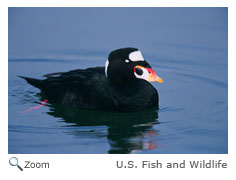 The surf scoter is a large sea duck measuring 19-24 inches in length. It got the nickname, "skunk-headed coot" from the black and white patterns on its head. Males and females look different. The surf scoter is a large sea duck measuring 19-24 inches in length. It got the nickname, "skunk-headed coot" from the black and white patterns on its head. Males and females look different.
Males are a deep black color, with one or two white patches on their heads. they have large bills that are is swollen at the base. The bill looks orange from far away, but is really white, red, yellow and black. Its eyes are light blue or yellow and its feet are reddish-orange.
Females are a lighter black and their bills are not as as large as the male and looks greenish-black, not red, from far away.
Range 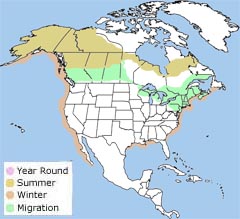 The surf scoter has a very large range. It breeds from western Alaska through Central Labrador in Canada. In the winter, the surf scoter lives along the Pacific and Atlantic coast in North America. Its winter range extends as far south as Baja California on the west coast and down to South Carolina on the east coast. Although not native to the area, the surf scoter has also been found as far away as Russia! The surf scoter has a very large range. It breeds from western Alaska through Central Labrador in Canada. In the winter, the surf scoter lives along the Pacific and Atlantic coast in North America. Its winter range extends as far south as Baja California on the west coast and down to South Carolina on the east coast. Although not native to the area, the surf scoter has also been found as far away as Russia!
Habitat
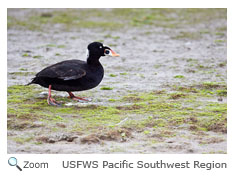 The surf scoter lives in both freshwater and marine habitats. In the summer, it lives and breeds on small bodies of fresh water in boreal forests or tundra landscapes. In the winter, the surf scoter lives in shallow ocean bays, estuaries and mouths of rivers along the west and east coast. It prefers habitats with pebble or sandy bottoms. The surf scoter lives in both freshwater and marine habitats. In the summer, it lives and breeds on small bodies of fresh water in boreal forests or tundra landscapes. In the winter, the surf scoter lives in shallow ocean bays, estuaries and mouths of rivers along the west and east coast. It prefers habitats with pebble or sandy bottoms.
|
|
Diet
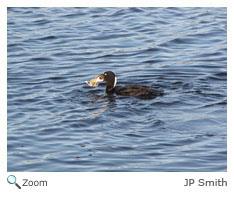 The surf scoter is a diving duck. It feeds on bottom-dwelling creatures. Its primary food source is mollusks. It also eats crustaceans, such as razor clams, worms and echinoderms. In the summer, the surf scoter eats insects, insect larvae and plant matter. The surf scoter is a diving duck. It feeds on bottom-dwelling creatures. Its primary food source is mollusks. It also eats crustaceans, such as razor clams, worms and echinoderms. In the summer, the surf scoter eats insects, insect larvae and plant matter.
Life Cycle
 Breeding begins in May or June, while the surf scoter is living on small bodies of fresh water in boreal forests or tundra landscapes. Females make their nests in shallow depressions along the water and line them with grass, plant material and feathers. Breeding begins in May or June, while the surf scoter is living on small bodies of fresh water in boreal forests or tundra landscapes. Females make their nests in shallow depressions along the water and line them with grass, plant material and feathers.
The female lays 6-9 creamy white eggs. The chicks hatch with downy feathers and their eyes open. Mothers protect their eggs only until the chicks hatch. Since mothers aren't very protective of their young, it is common for young surf scoters to get mixed up with the wrong family on crowded lakes. Once the chicks are dry, they leave the nest and are able to feed themselves immediately.
Behavior
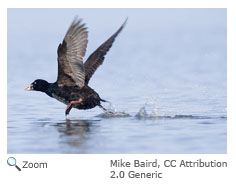 Although adult surf scoters fly back north for the summer, some young surf scoters don't. Instead, they spend the summer along the coast of Baja California or New Jersey. Although adult surf scoters fly back north for the summer, some young surf scoters don't. Instead, they spend the summer along the coast of Baja California or New Jersey. |


 The surf scoter has a very large range. It breeds from western Alaska through Central Labrador in Canada. In the winter, the surf scoter lives along the Pacific and Atlantic coast in North America. Its winter range extends as far south as Baja California on the west coast and down to South Carolina on the east coast. Although not native to the area, the surf scoter has also been found as far away as Russia!
The surf scoter has a very large range. It breeds from western Alaska through Central Labrador in Canada. In the winter, the surf scoter lives along the Pacific and Atlantic coast in North America. Its winter range extends as far south as Baja California on the west coast and down to South Carolina on the east coast. Although not native to the area, the surf scoter has also been found as far away as Russia!



